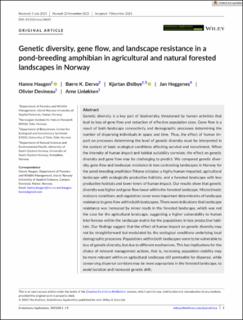Genetic diversity, gene flow, and landscape resistance in a pond-breeding amphibian in agricultural and natural forested landscapes in Norway
Haugen, Hanne; Dervo, Børre Kind; Østbye, Kjartan; Heggenes, Jan; Devineau, Olivier; Linløkken, Arne N.
Peer reviewed, Journal article
Published version

View/
Date
2023Metadata
Show full item recordCollections
- Publikasjoner fra CRIStin - NINA [2364]
- Scientific publications [1392]
Abstract
Genetic diversity is a key part of biodiversity, threatened by human activities that
lead to loss of gene flow and reduction of effective population sizes. Gene flow is a
result of both landscape connectivity and demographic processes determining the
number of dispersing individuals in space and time. Thus, the effect of human impact
on processes determining the level of genetic diversity must be interpreted in
the context of basic ecological conditions affecting survival and recruitment. When
the intensity of human impact and habitat suitability correlate, the effect on genetic
diversity and gene flow may be challenging to predict. We compared genetic diversity,
gene flow and landscape resistance in two contrasting landscapes in Norway for
the pond-breeding amphibian Triturus cristatus: a highly human-impacted, agricultural
landscape with ecologically productive habitats, and a forested landscape with less
productive habitats and lower levels of human impact. Our results show that genetic
diversity was higher and gene flow lower within the forested landscape. Microclimatic
moisture conditions and vegetation cover were important determinants of landscape
resistance to gene flow within both landscapes. There were indications that landscape
resistance was increased by minor roads in the forested landscape, which was not
the case for the agricultural landscape, suggesting a higher vulnerability to human
interference within the landscape matrix for the populations in less productive habitats.
Our findings suggest that the effect of human impact on genetic diversity may
not be straightforward but modulated by the ecological conditions underlying local
demographic processes. Populations within both landscapes seem to be vulnerable to
loss of genetic diversity, but due to different mechanisms. This has implications for the
choice of relevant management actions, that is, increasing population stability may
be more relevant within an agricultural landscape still permeable for dispersal, while
conserving dispersal corridors may be more appropriate in the forested landscape, to
avoid isolation and increased genetic drift.
agriculture, forest, gene flow, genetic diversity, landscape resistance, Triturus cristatus
